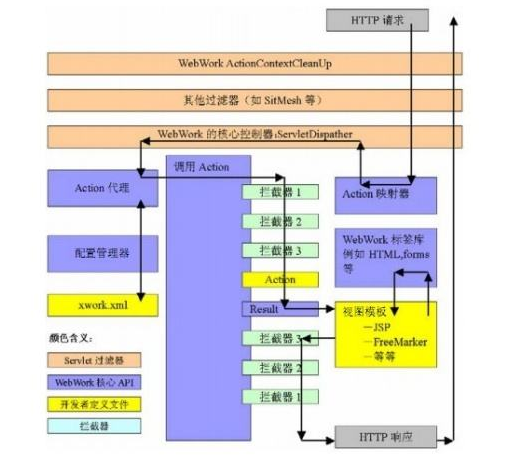struts原理图


n the diagram, an initial request goes to the Servlet container (such as Jetty or Resin) which is passed through a standard filter chain. The chain includes the (optional) ActionContextCleanUp filter, which is useful when integrating technologies such as SiteMesh Plugin. Next, the required FilterDispatcher is called, which in turn consults the ActionMapper to determine if the request should invoke an action.
If the ActionMapper determines that an Action should be invoked, the FilterDispatcher delegates control to the ActionProxy. The ActionProxy consults the framework Configuration Files manager (initialized from the struts.xml file). Next, the ActionProxy creates an ActionInvocation, which is responsible for the command pattern implementation. This includes invoking any Interceptors (the before clause) in advance of invoking the Action itself.
Once the Action returns, the ActionInvocation is responsible for looking up the proper result associated with the Action result code mapped in struts.xml. The result is then executed, which often (but not always, as is the case for Action Chaining) involves a template written in JSP or FreeMarker to be rendered. While rendering, the templates can use the Struts Tags provided by the framework. Some of those components will work with the ActionMapper to render proper URLs for additional requests.
All objects in this architecture (Actions, Results, Interceptors, and so forth) are created by an ObjectFactory. This ObjectFactory is pluggable. We can provide our own ObjectFactory for any reason that requires knowing when objects in the framework are created. A popular ObjectFactory implementation uses Spring as provided by the Spring Plugin.
Interceptors are executed again (in reverse order, calling the after clause). Finally, the response returns through the filters configured in the web.xml. If the ActionContextCleanUp filter is present, the FilterDispatcher will not clean up the ThreadLocal ActionContext. If the ActionContextCleanUp filter is not present, the FilterDispatcher will cleanup all ThreadLocals.
struts原理图的更多相关文章
- 4.Struts2转向类型详解
struts2中提供了多种视图转向类型,类型由type属性指定,如: dispatcher:请求转发(默认值) redirect:重定向到页面 redirectAction:重定向到Action pl ...
- 最佳新秀SSH十六Struts2它是如何工作的内部
前面说完了Spring.Hibernate,非常自然今天轮到struts了.struts的核心原理就是通过拦截器来处理client的请求,经过拦截器一系列的处理后,再交给Action.以下先看看str ...
- 菜鸟学SSH(十六)——Struts2内部是如何工作的
前面说完了Spring.Hibernate,很自然今天轮到struts了.struts的核心原理就是通过拦截器来处理客户端的请求,经过拦截器一系列的处理后,再交给Action.下面先看看struts官 ...
- 轻量级Java EE开发框架设计系统应用架构
首先来说一下Java EE 概述 其中常说的三大框架即是:ssh Spring:功能强大的组件粘合济,能够将你的所有的java功能模块用配置文件的方式组合起来(还让你感觉不到spring的存在)成为一 ...
- Struts 2.3.24源码解析+Struts2拦截参数,处理请求,返回到前台过程详析
Struts2官网:http://struts.apache.org/ 目前最新版本:Struts 2.3.24 Struts1已经完全被淘汰了,而Struts2是借鉴了webwork的设计理念而设计 ...
- Struts 2知识回顾----拦截器(Intercept)总结
什么是Struts 2拦截器? 从软件构架上来说,拦截器是实现了面向方面编程的组件.它将影响了多个业务对象的公共行为封装到一个个可重用的模块,减少了系统的重复代码,实现功能的高度内聚,确保了业务对象的 ...
- Java Web编程的主要组件技术——Struts入门
参考书籍:<J2EE开源编程精要15讲> Struts是一个开源的Java Web框架,很好地实现了MVC设计模式.通过一个配置文件,把各个层面的应用组件联系起来,使组件在程序层面联系较少 ...
- Struts面试笔记
Struts2面试题1.struts2工作流程Struts 2框架本身大致可以分为3个部分:核心控制器FilterDispatcher.业务控制器Action和用户实现的企业业务逻辑组件. 核心控制器 ...
- struts详细解释拦截器
1.拦截器:Struts2拦截器将一个Action要么Action的方法.之前或截取后场,和Struts2拦截器是可插拔,拦截器AOP一种实现. WebWork:拦截器是动态拦截Action调用的对象 ...
随机推荐
- Spring boot 下使用 Swagger
通过Swagger 可以更好的将后台的RESTfull API文档化,如下图所示: 1. Swagger 主要依赖以下两个jar包: <!-- https://mvnrepository.com ...
- 【Eclipse】将Tab替换为空格
工作中由于TAB和空格的占位不一样,在比对代码的时候,总是对齐方式不正确. 所以,就网搜了下Tab替换空格的方式,还不错哦,记录下来. 操作如下: 1.点击 window->preference ...
- [转]【ROLLUP】Oracle分组函数之ROLLUP魅力
原创:http://blog.itpub.net/519536/viewspace-610995 本文通过演示给出Oracle ROLLUP分组函数的用法,体验一下Oracle在统计查询领域中的函数魅 ...
- gentoo intel 安装桌面
首先增加 vim ~/.xinitrc [[ -f ~/.Xresources ]] && xrdb -merge ~/.Xresources # dbus before fcitx ...
- redis 连接超时。。
在虚拟机安装后.在项目中加入redis 想测试一下功能 然后在物理机死活连不上. 1.用物理机ping 虚拟机的IP 通.... 2.然后.把redis.conf 里面bind 0.0.0.0 依然没 ...
- iOS基础知识之排序
1.字符串比较 - (NSComparisonResult)compare:(NSString *)str; 例如: NSString *str1 = @"zhangsan"; N ...
- Mybatis学习4——一对一关联查询方法2------实体作为属性
实体order和user采用resultMap order package pojo; import java.util.Date; public class Order { private Inte ...
- 1. 在config.ini文件中加入dm.park.time=1,会使uap中的tomcat启动加快
在config.ini文件中加入dm.park.time=1,会使uap中的tomcat启动加快
- spring boot 整合redis --sea 方式1
application.properties # REDIS (RedisProperties) # Redis数据库索引(默认为0) spring.redis.database=0 # Redis服 ...
- kubernetes安装过程报错及解决方法
1.your configuration file uses an old API spec: "kubeadm.k8s.io/v1alpha2". 执行kubeadm init ...
